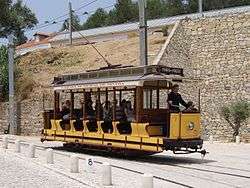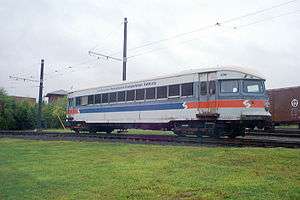J. G. Brill Company
| Privately held company | |
| Industry | Rail transport |
| Genre | Public transport |
| Founded | 1868 |
| Founder | John George Brill |
| Defunct | 1954 |
| Headquarters | Philadelphia, Pennsylvania, United States |
| Products | Streetcars (trams), interurban railcars, motor buses, and trolleybuses |

The J. G. Brill Company manufactured streetcars, interurban coaches, and buses in the United States for almost ninety years. The company was founded by John George Brill in 1868 as a horsecar manufacturing firm in Philadelphia. Over the years, it absorbed numerous other trolley-interurban manufacturers such as Kuhlman in Cleveland and Jewett in Indiana. With business diminishing, in 1944 it merged with the American Car and Foundry Company (ACF) to become ACF-Brill. It ceased trolley and bus production in 1954, though some of their interurbans served the Philadelphia area till the 1980s. Brill was the longest lasting of the nation's trolley and interurban manufacturers. It manufactured over 45,000 streetcars, trams (also known as trolleys or trolley cars in the U.S.),[1] motor buses, trolleybuses and railroad cars. At its height, it was the largest manufacturer of streetcars and interurbans in the U.S. and produced more streetcars and interurbans and gas electrics than any other manufacturer.
History
In 1868, the Brill company was founded as J.G. Brill and Sons. After James Rawle joins the firm in 1872, it is renamed J.G. Brill & Company.[2]

In 1926, ACF Motors Company obtained a controlling interest in Brill, and in 1944 the two companies merged, forming the ACF-Brill Motors Company.[3] ACF-Brill announced in 1944 that Canadian Car and Foundry of Montreal, Quebec were licensed to manufacture and sell throughout Canada motor buses and trolley coaches of their design as Canadian Car-Brill. The firm built about 1,100 trolley buses and a few thousand buses under the name.
On January 31, 1946, a controlling interest in ACF-Brill was acquired by Consolidated Vultee Aircraft Corporation for $7.5 million. Consolidated Vultee was sold on November 6, 1947, to the Nashville Corporation, which sold its share to investment firm Allen & Co., headed by Charles Allen, Jr., on June 11, 1951. In early 1954, the Brill name disappeared when ACF-Brill ceased production and subcontracted remaining orders.[4]
Companies
The American Car & Foundry Co. controlled, as of January 26, 1926:
- The Brill Corporation, which controlled:[5]
- American Car & Foundry Motors Co: owned Hall-Scott Motor Car Co (owned 100%) and Fageol Motors (Ohio) (controlled 90%)
- The J. G Brill Company, 62nd and Woodland Streets, Philadelphia. Absorbed and owned American Car Company (1902) (not American Car and Foundry), Kuhlman Car Co. (1904) of Cleveland, Wason Manufacturing Company (1907) of Springfield, MA., Stephenson Car Co. (1904) of Elizabeth, NJ, and the stock of Hall-Scott of San Francisco (1926).Obtained a controlling share of the Danville Car Company (1908) which dissolved in 1911.
In Europe, Cie. J. G. Brill of Gallardon, France (founded 1908) was sold to Electroforge in 1935.[2]
Other companies that built licensed versions of Brill vehicles:
- Canadian Car and Foundry – Peter Witt streetcars, trolley buses and motor buses
Canadian railway car builder Preston Car Company was acquired in 1921 and operations were closed in 1923.
Products
- Fageol/Brill Twin Coach 44S.
- Birney safety car – by subsidiary, the American Car Company.
- Traditional arch-windowed, all-wood interurban cars. 1890-1920s.
- Steel heavy interurban cars built 1920-1930s. The Brill "Center Door" car was typical of suburban trolleys and interurbans built around 1920. These tended to be large, heavy, double-ended cars, with passengers entering and exiting via doors located at the center of the car. Many rebuilt into one man cars.[Springirth,p86-100]
- Brill "Master Unit," built 1930s. All-steel; had standard controller stand, capable of 70 mph.[p86-100]
- Brilliner – Brill's competitor to the PCC (Presidents' Conference Car) looked somewhat like the first PCCs. The Brilliner was not successful when compared to the PCC. Underpowered. Few were sold, whereas PCCs were well sold worldwide. Twenty-four built for Atlantic City's Miss America Fleet.[Springirth p86-100]
- Brill "Bullet" car. 1929–1932. For suburban/interurban use.[Springirth, p86-100]

- Brill diners - Brill sold and designed diners, generally through one of its four subsidiaries, the Wason Manufacturing Company. The last one believed to be operating is the Capitol Diner in Lynn, Massachusetts, which is listed on the National Register of Historic Places.
- Peter Witt streetcar
- Large cars with trailers
- Small cars
- Numerous models of trolleybuses, including T30, T40, 40SMT, 44SMT and, as ACF-Brill, TC44 and T46/TC46
- C-36 city bus
- IC-41 intercity bus
The unique Bullet cars

The lines that operated interurban passenger cars recognized in the mid-1920s that they needed to build faster, quieter, more power efficient equipment. Up to that time, both the wood and most of the steel interurban cars were large, sat high, and were heavy. Streetcars were slow, noisy, and clumsy to operate using the motor controller "stand" of the time. Car manufacturers such as Cincinnati Car Co. (who already in 1922 made a lightweight, albeit slow, interurban), St. Louis Car Co., Pullman, and Brill worked to design equipment for a better ride at extremely high speed, improved passenger comfort, and reduced power consumption. This particularly involved designing low-level trucks (bogies) able to handle rough track at speed. Brill, in conjunction with Westinghouse and General Electric, worked on a new interurban design and on a new streetcar design. (The PCC). The interurban design result was the aluminum and steel wind tunnel (the first in the railway industry) developed slope roof "Bullet" MU cars, the first of which were purchased in 1931 by the Philadelphia and Western Railroad, a third rail line running from 69th Street Upper Darby to Norristown in the Philadelphia region.[4] This line still runs as SEPTA's Norristown High Speed Line. The Bullets could attain speeds as high as 92 mph (148 km/h).[6] They were very successful and operated until the 1980s, but Brill sold few others. Only the central New York state interurban Fonda, Johnstown, and Gloversville Railroad which terminated at Schenectedy ordered Bullets, albeit a single-ended, single-unit "trolley-ized" version. Five were procured in mid-Depression 1932 for passenger business that was rapidly declining. In 1936, the closing FJ&G sold these Bullets to the Bamberger Railroad in Utah, which ran them in high-speed service between Salt Lake City and Ogden until the mid-1950s.[2] Three of the SEPTA Bullet cars are now at the Seashore Trolley Museum, one is at the Electric City Trolley Museum in Scranton, one is at the Rockhill Trolley Museum in Orbisonia PA, one is at the National Museum of Transportation in St. Louis MO, and one is at the Pennsylvania Trolley Museum in E. Washington. A Bamberger Bullet is in the Orange Empire Railroad Museum in Perris, Southern California, and another one has been preserved by the Utah State Railroad Museum; a third is a part of a restaurant building in Springville, Utah, but is barely recognizable as a Bullet.
Brill cars in the modern era
JR Kyushu's Aru Ressha theme train is based on a luxury Brill car ordered by the Kyushu Railway company in 1906. Due to its nationalization (under Japan's Railway Nationalization Act), the car was never put into service.[7]
Clients
- Aroostook Valley Railroad – rural interurban line
- Dunedin City Tramways
- Erie Railroad
- Ferrocarriles de Cataluña SA (now Ferrocarrils de la Generalitat de Catalunya – Barcelona–Vallès Line)
- Hamilton Street Railway
- Helsinki tramways, Finland
- Invercargill Tramways (until 1950) – the world's southernmost light railway system
- Lisbon tramway system – Carris Company, Portugal
- Melbourne Electric Supply Company – Geelong tram system
- New Plymouth Electric Tramways, New Plymouth, New Zealand
- Philadelphia Rapid Transit – streetcar system.
- Philadelphia and Western Railroad – interurban electric railroad
- Philadelphia Suburban Transportation Company (Red Arrow Lines) – interurban electric railroad
- Scranton, Montrose and Binghamton Railroad (Northern Electric) – interurban electric railroad
- South Australian Railways[8]
- Tennessee, Alabama and Georgia Railway – Pigeon Mountain Scooters 1922–1951
- Toronto Transportation Commission
- Tranvía Municipal de Bogotá-Colombia (first called the Bogotá City Railway Co. and then Tranvía Municipal de Bogotá) The Tramway 1884–1947
- Wellington Corporation Tramways
- Numerous U.S. interurban and street railway systems
See also
References
- 1. Middleton, Wm D. "The Interurban Era," Kalmbach Publishing, Milwaukee. List of U.S. interurban car manufacturers, pp 416–417. Bullet design, p 68-70.
- 2. Volkmer. "Pennsylvania Trolleys in Color." Photographs pf P&W Bullets and SEPTA Bullets. Brilliners, built 1932.
- 3. Hilton, George. "The Electric Interurban Railways in America," Stanford Univ Press. Development of improved interurban car design. (eight pages)
- 4. Springirth. Development of Bullet design.
- 5. Bradford, Francis H. "Hall-Scott: The Untold Story of a Great San Francisco American Engine Maker"
Bibliography
- ↑ Young, Andrew D. (1997). Veteran & Vintage Transit, p. 101. St. Louis: Archway Publishing. ISBN 0-9647279-2-7.
- 1 2 Brill, Debra (21 August 2001). History of the J. G. Brill Company (Series: Railroads Past and Present). Indiana University Press. ISBN 0253339499.
- ↑ Sebree, Mac; and Ward, Paul (1973). Transit's Stepchild: The Trolley Coach, p. 127. Los Angeles: Interurbans. LCCN 73-84356.
- ↑ "The J.G. Brill Company". American-Rails.com. Retrieved 2016-02-23.
- ↑ Brill (2001), p 165.
- ↑ Middleton, p. 72
- ↑ "Aru Ressha Concept". Aru Ressha Official Website. JR Kyushu.
- ↑ Brill Railcars of the South Australian Railways Bird, K Australian Railway Historical Society Bulletin, October;November;December 1981 pp213-236;237–260;272–282 January 1982 pp1-8
Other Citations
- Brill, Debra (2001). History of the J. G. Brill Company. Bloomington: Indiana University Press. ISBN 0-253-33949-9. The author of this book is a direct descendant of company founder John George Brill of the JG Brill Company of Philadelphia, manufacturer for many years of street cars, interurban cars, the famous "Bullet" cars, and buses. The largest (number produced) manufacturer of such equipment in the world. Over time, absorbed other manufacturers of interurban cars and street cars.
- Middleton, Wm. D (2000) [1962]. The Interurban Era. Milwaukee, WI: Kalmbach Books. ISBN 978-0-89024-003-8.
- Volkmer, Wm. D. Pennsylvania Trolleys in Color, Vol II, Philadelphia Region. 92pp. Morning Sun Books, Scotch Plains, NJ. 1998. ISBN 1-878887-99-8. Photographs of Brilliners and Bullets and other Brill designs on Philadelphia and Westernline and in shops.
- Hilton, George and Due, John The Interurban Electric Railway in America, Stanford University Press, Stanford, CA. Reissue 2000.
- Springirth, Kenneth. Suburban Philadelphia Trolleys 128pp. Arcadia Publishing, 2007. (ISBN 9780738550435)
External links
| Wikimedia Commons has media related to Brill vehicles. |
- History of J. G. Brill Company
- The J.G. Brill Company Records, including approximately 16,000 photographs, are available for research use at the Historical Society of Pennsylvania.
- Brill Bullet
- Photos of Red Arrow Trolleys, including Brill cars
- Brill history and photos
- The Tramways of Colombia